Vagabonding in Asia 2009, part 3 of 11: Northern China
|
Part 1 China, southeast |
Part 2 China, southwest |
Part 3 China, north |
Part 4 Tibet |
Part 5 Nepal |
Part 6 India, south |
|
Part 7 Malaysia |
Part 8 Sumatra and Java |
Part 9 Bali and Lombok |
Part 10 Australia |
Part 11 Laos, Cambodia, Bangkok |
Tour dates: 17 March - 17 May 2009.
Air travel is shown in blue; bus and train travel is shown in pink.
The starting point was Hong Kong.
The main attraction in Xi'an are the terracotta warriors. Qin Shi Huang, the first Chinese emperor who unified the whole of China under his rule two thousand years ago, appears to have had tastes that ran to the extravagant, so he had a huge mausoleum built for himself (yet unexcavated), plus an army of 7000 terracotta warriors. Maybe a lot more, 7000 have been found so far. They were all highly detailed, with faces believed to match those of people they represented, and armed, although very little made of wood survived.
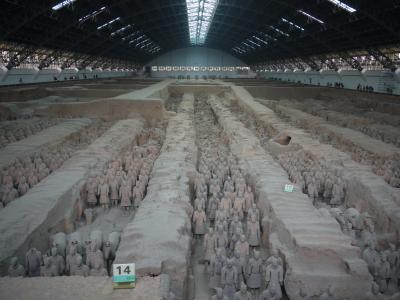
| 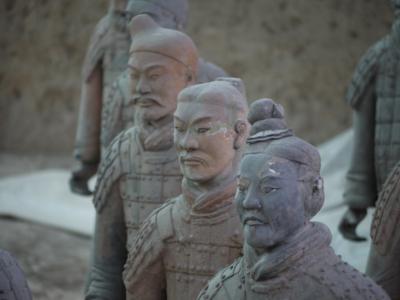
|
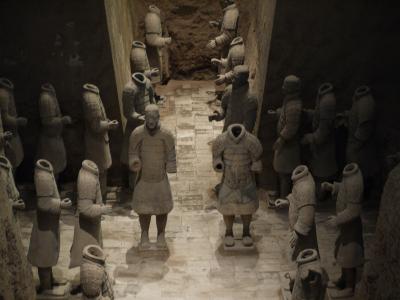
| 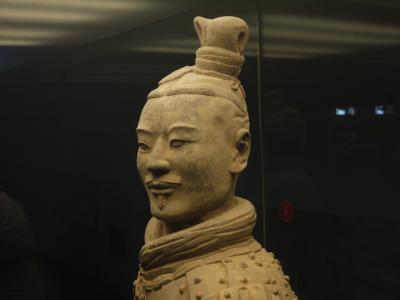
|
| Terracotta warriors at Xi'an | |
The place got sacked soon after he died, so many of the statues are headless and broken, but archaeologists have put most of them back together. Others were left like they were found, to document the damage; and a large number were reburied to protect them. They were painted but the paint decays very quickly when exposed to air; all statues on display showed no colors. The warriors are in three "pits", roofed over; one small officer's headquarter and two large arrays of 1300 and 6000 soldiers. A walkway runs around the actual pits so one can't get really close to the army, but it's still a stunning site. They also have a museum and a 360 degree movie theater that runs an documentary. The museum looks like it was built for very large numbers of visitor, and long lines, but it was fairly empty.
I spent the rest of the day in Xi'an. Most of the city is modern and, as usual, uninteresting, but they have a Muslim quarter that has escaped modernization. Lots of atmosphere there, narrow streets, busy craftsmen working on the street, Chinese shops, and lots of carts that sell food. Had great Dim Sum at several carts. The Muslim quarter also has some tourist streets where the tour groups get funneled through to buy souvenirs. It always amazes me how tour groups concentrate on the proscribed route and never stray to the places that are actually interesting and (more or less) authentic, maybe just a few meters away. The contrast between the souvenir streets and the rest is extreme.
Yuncheng is a modern city but decidedly not shiny. Many downtown buildings are totally hidden behind billboards. I stayed in the best hotel, recommended by the Lonely Planet, but it's dank, dark, and not too clean, and very noisy at night. In the evening someone knocked at my door, and I check to see what's wrong. A woman pushes into the room and closes it behind her, gesticulating. I threw her out. The hookers are quite aggressive here.
Yuncheng does have some lively side streets with markets. They sell good street food here. It seems that no Westeners go to this city (I am not surprised, who'd want to spend time in this dump), people kept staring at me...
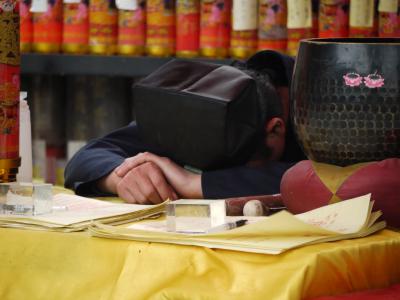
| 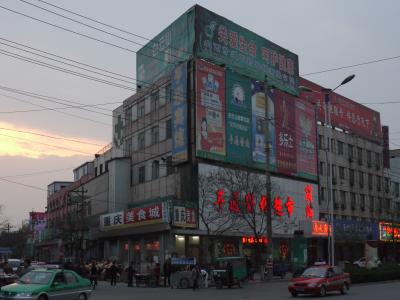
|
| Tao monk at the Guan Yu temple near Yuncheng | Downtown of Yuncheng |
The reason to see Yuncheng is a very large Taoist temple dedicated to Guan Yu. It consists of lots of Ming-era (16th century) pagodas and a long series of elaborate but decaying gate buildings, in a park with blooming trees and little ponds. The final gate consists of two cavernous floors, but there isn't much of a view. There are very few visitors, just a group of Chinese tourists who wanted their picture taken with me. They also have a shooting range with palm-sized paper targets and two huge naval guns with bores bigger than the targets.
The bus from Yuncheng to Pingyao dropped me off right on the side of the six-lane freeway. The driver pointed at the nearest exit and off he went. Apparently this is common practice, some people with motorcycles were waiting a short walk later. One led me through a barbed wire fence, and he took me downtown, first across the fields and then through the dilapidated modern part of the city outside of the city walls.
I was staying in the Yamen Youth Hostel. I seem to have better luck with hostels than hotels, and this one is great - it's in a 400-year old governor's residence. There are a number of courtyards with side buildings, each with four large original rooms. The rooms are furnished in the old style with a gigantic bed that fills a third of a large room. The bed basically a raised platform covered with futons. In museums I have seen variants that have stoves built in for heating in the winter, and in offices people sit cross-legged on them to conduct business. I bet the governor didn't have a bathroom though, unlike my room. It's in Pingyao's historic walled downtown, where vehicles can't go during most of the day.
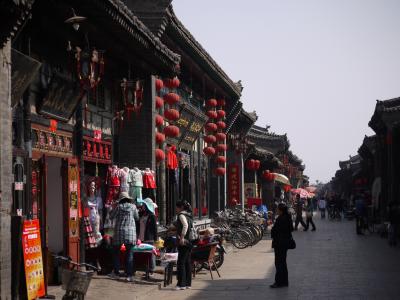
| 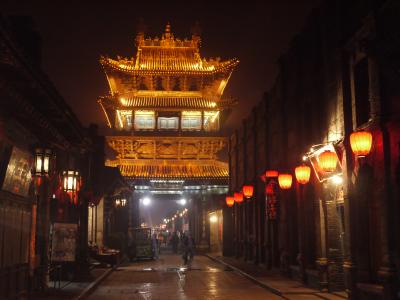
|
| Old town of Pingyao | Pingyao at night |
Pingyao was rich during Ming times in the 16th century, but it's been poor for the better part of the century. Too poor to tear down all those beautiful low Ming-era buildings lining all its streets and replace them with ugly concrete boxes with white bathroom tiles on the outside, and too poor to replace the imposing city wall that keeps the concrete outside with tour bus parking lots. Most of the old town is in good repair, and it really feels like an authentic Ming town and not dolled up for tourists. Of course it can't possibly be five hundred years old and still look so good, but they did an excellent job. There aren't even a lot of souvenir shops. Once again, I am paying for the absence of tour groups with gray skies.
I bought the city admission ticket and visited a 14th-century government complex (quite spartan rooms), a more elaborate Taoist temple complex for all sorts of gods including a kitchen god, and a Confucian temple complex. The Confucian temple has a photography museum that mostly shows 1930's and 1940's war pictures, although I recognized a series of Marrakech pictures. After tha I felt kind of templed out and went to the hostel to write it all up.
At night, the hostel hat a "dumpling party", and I learned how to make Wan Tan like dumplings. It's all in the way you hold your hands when folding the dumpling. Cut out round little sheets of dumpling dough, place a teaspoon of filling in the middle, making sure that it doesn't spill too close to the edge, and fold it over. Then fold your hands like when praying, except a little more open, place the semi-circular edge of the dumpling between your index finger and both thumbs, and press both thumbs very hard against your index finger. That's all.
Saturday, 11 April 2009
The Chinese love English signs. They are everywhere. Mind you, they can't read English and don't understand what's on them, so you get the most hilarious mistranslations. Near rests the lodging, the foot cures the massage, Lei Lutei's residence is built 180 years from now, Mr. Qu gets married if every tourist is interesting in this, in order to be fit of requirement of the plenty tourist, tell you tong xing gong escort service mind glass... They use English not so much to convey a message but as sophisticated decoration. On the other hand, every Chinese bookstore has a whole section on English learning books, and a very peculiar selection of classical English-language texts.
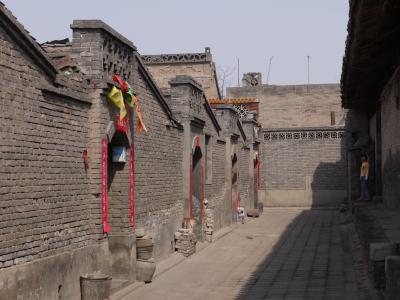
| 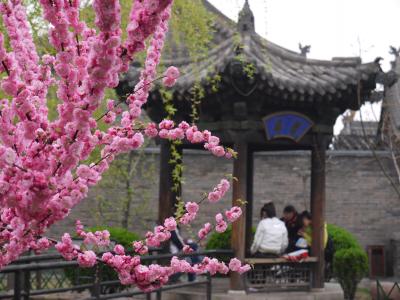
|
| No souvenirs sold here. | Plums blooming in the palace garden |
It was warm and sunny, so I walked about town for eight hours straight, including halfway around the top of the city wall. Pingyao's old town is *big*. They have many little museums and sights - temples, residences, banks, and government offices, many dating back to the 16th century. They all follow the same pattern: an entrance building facing the street with a number of courtyards behind it. The first and final buildings are usually larger, and sometimes have two floors. Everything is built with gray brick and wooden pillars and flaring shingled roofs with dragon ornaments, and latticed windows with paper instead of glass. Bedrooms (even in banks and offices) have large heated brick beds, and there is always a little shrine somewhere. But after a while you get the idea, and the places sort of blur together.
I spent the next morning and early afternoon walking around Pingyao, since this is probably my last chance to enjoy a beautiful old town in China and its cuisine. I gorged one last time of the local Dim Sum.
Taiyuan is a few hours north of Pingyao by bus. It's an unremarkable modern town, but much enlivened by plants an little parks. Ailing trees line its main boulevards. I sat in a green square for a few hours waiting for my train, watching children skate.
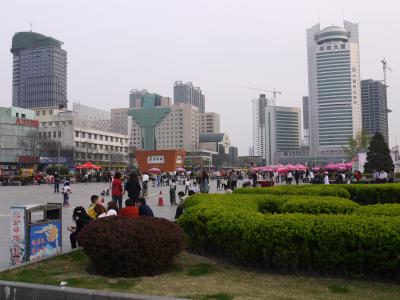
| 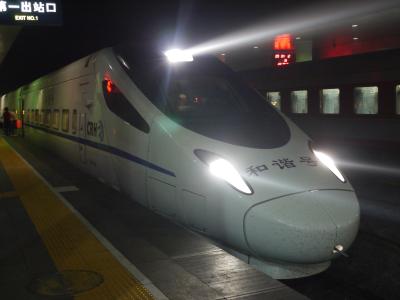
|
| Central square in Taiyuan | High-speed train to Beijing |
The high-speed train to Beijing is more functional than elegant, but it's modern, new and spotless, and quiet, like European intercities. It goes 160 km/h most of the time, 200 for some sections, and reached a top speed of 250. I was in Beijing after only three hours, but by then it was way too late to do any sightseeing. Beijing is large so I had to look for a taxi to get me to my hostel. There are very few late at night, and I had to shop around for a while to get a reasonable price.
The next day I embarked on a five-hour odyssey to get my onward travel booked. If all goes well, I'll be on a train to Lhasa on Friday. Tibet requires two special permits, which take five days to process. All aspects of the tour must be submitted and approved by the authorities. I am greatly looking forward to Tibet. Later I wished that I had put a few more places on the permit, because you can skip places but once in Tibet, there is no way to stray even one kilometer from the approved path. Obviously, when the forms ask for your profession, don't write down anything that is even remotely connected to journalism.
I decided that my first Beijing experience will be authentic Peking Duck. Everybody offers that here but I chose the upscale Quanjude Roast Duck Restaurant, and ordered half a duck with all the options. Shortly after, a chef rolled up a workbench to my table and deftly carved the duck into bite-size pieces, each of which is carefully arranged on a plate, with the best part of the skin on a separate plate. A waitress demonstrated the proper procedure: take a thin pancake, arrange some duck dipped in a dark mu-shu sauce, vegetables, skin, and roasted garlic on it, and fold it to a small pocket. It's absolutely delicious. The meat is tender, the skin is crisp yet glossy with grease, but it somehow doesn't taste greasy at all. Wonderful. You haven't eaten Peking Duck if you didn't eat it in Beijing. Of course it was fantastically expensive - 15 euro!
On the way into the Quanjude restaurant, everyone had to stand aside to let an evidently very rich lady pass, with four porters who carried several shopping bags each to her waiting stretch limo, while shopkeepers were bowing. China is a very odd communist country - extreme poverty coexists with extreme wealth. I have never seen such an ostentatious display of wealth in Europe, the rich tend to be much more discreet there.
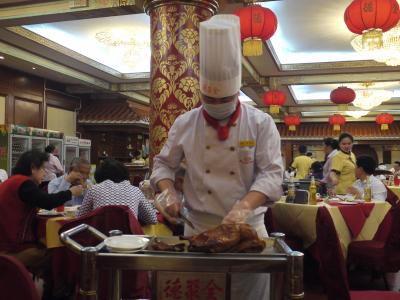
| 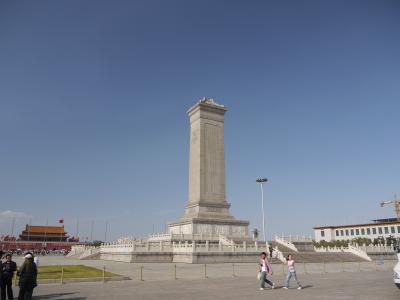
|
| Peking duck served at Quanjude restaurant | Tiananmen Square in Beijing |
Tiananmen square is huge, but not as large and as forbidding as I expected. I guess we all associate tanks with the name, but there is a lot of green, with tourists strolling and taking pictures, and a fat obelisk in the center. It's sunny and quite hot, and a van sells drinks at low supermarket prices, is that supposed to be capitalism? In order to get onto the square, I had to pass a police checkpoint and had my bag inspected. A few soldiers guard the square, but it's all very civilized and friendly.
I have no doubt that these soldiers are not just decoration though. I remember those pictures from the Tiananmen massacre of 1989, when tanks rolled against human rights protesters. When one protester walked in front of a tank, the tank repeatedly tried to turn to the side to avoid injuring the man, who kept stepping forward and blocking the tank. All the security here is probably intended from ever allowing a repeat of that day ten years ago.
In the late afternoon a wind came up, it got cooler, and the sun disappeared into a yellow haze. It's a mild sand storm, very fine sand started getting into my eyes and my ice cream. I read that these sand storms can become quite serious in summer. So I took a tuk-tuk back, a little enclosed wooden box with plastic windows mounted on a tricycle.
China is supposed to be the country of bicycles, but I have seen very few cyclists. Cars have taken over Beijing and other cities, and electric scooters. I like those scooters, I am glad they didn't opt for these offensively noisy mock motorcycles that clog so many French cities. Right of way is determined by mass - bigger is better. Even old ladies at zebra crossings are mercilessly cut off. Like last night, the driver got confused by the hutongs (narrow old lanes) around the hostel; about a third of the old hutongs have escaped modernization and road widening. They are not ancient like in Pingyao, but much nicer to stroll in than the big roads packed with traffic.
The Chinese Great Wall is not like a road. Roads follow convenient low paths like rivers. The Great Wall, on the other hand, unfailingly picks the most impractical and difficult points of the terrain imaginable - the highest and steepest ridges and peaks no matter how they curve. I wouldn't want to have to carry even one stone up there, but they built 8000 kilometers of it in 1368 to 1567, of which 2000 kilometers remain today.
Most tourists visit the wall at Badaling close to Beijing, but that's a crowded zoo crawling with tourists and souvenir vendors. I joined a group that went to Jinshanling, three hours by bus north of Beijing. We hiked ten kilometers on top of the wall to Simatai. There are very few people here, and the group quickly disperses until I rarely see another visitor. There are at least a few people selling warm water, Coca Cola, and beer (it's a hot sunny day again and the Ming rulers neglected to properly plan the wall with power outlets).
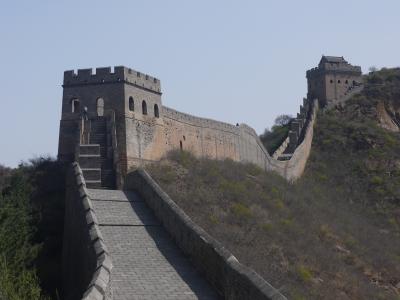
| 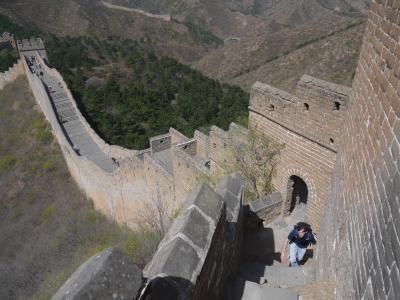
|
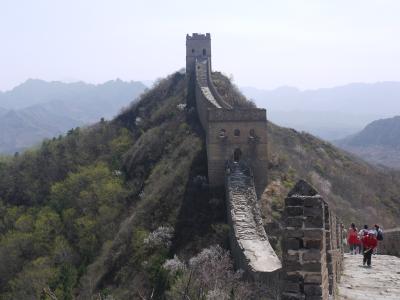
| 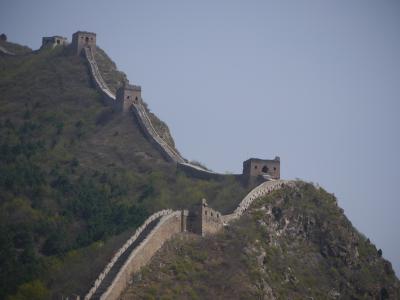
|
| Great Wall from Jinshanling to Simatai | |
"Hiking" doesn't properly capture the situation though - since the wall is constantly climbing some hill, so were we. There is never a flat section, always stairs that are often extremely steep and in poor repair. Away from the endpoints, it's sometimes just rubble; even the crenellations are missing in some places. There are guard towers in regular intervals; a few are in ruins. It's quite exhausting but the views are fantastic. How they could ever hope to move an army up there to the right spot to defend the wall, without satellite reconnaissance and back roads, is a mystery to me. The wall was not very effective repelling invaders, but if nothing else it makes a terrific Unesco World Heritage site.
At Simatai we needed to cross a river on an Indiana Jones suspension bridge, complete with wooden planks with gaps high above the river. There were no natives shooting arrows at us and hacking away at the cables though. Past the bridge, there is a dammed reservoir fed by the river with mountains on both sides. I could have walked down to a little village where the bus waits, but I heard some people in mid-air over the lake scream and whoop, so I investigated and opted for a zipline cable ride across the lake.
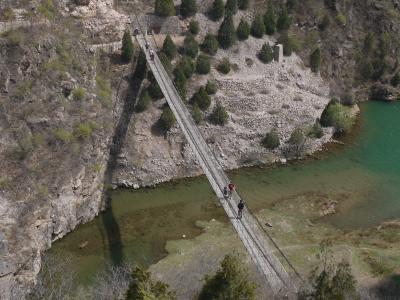
| 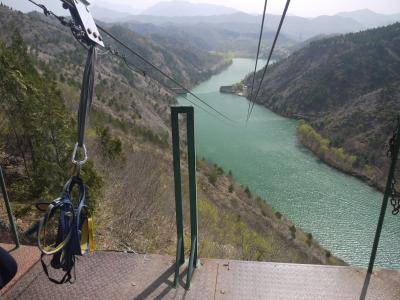
|
| Suspension bridge at Simatai | Zipline across the lake at Simatai |
I got a belt harness, basically three loops of rope around my legs and waist, which was hooked into a steel cable that ran across the lake. I sat down on a ledge high up the mountain on one side, looking down the precipice below with cables descending steeply, wondering if this was a good idea after all. Then I kicked off and rapidly shot down the cable across the lake with the mountain panorama all around me. It's totally exhilarating, and over much too quickly!

|
These days, the Forbidden City is forbidden only to smokers. The big sights that everyone knows come first - three huge halls, separated by gates, and the gigantic yards with the elaborate stairs leading up to them. After that it gets down to business; lots of smaller halls, the bigger ones with thrones for the emperor, the smaller ones for princes, concubines, and government functions. They all have flowery names like "pavilion of mental cultivation". The smaller buildings are in the back of the Forbidden City, and look a little like the Pingyao youth hostel, except bigger, more elaborate, and less well maintained. They show huge collections of jade, silver filigree, bronze, gold, precious stones, and ceramics. They also have a pretty bizarre clock collection; one can paint Chinese characters with a brush.
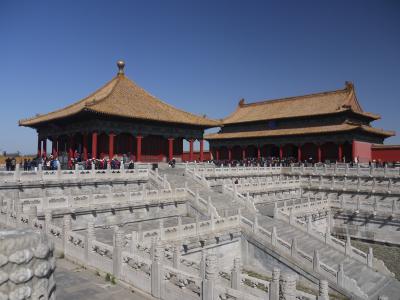
| 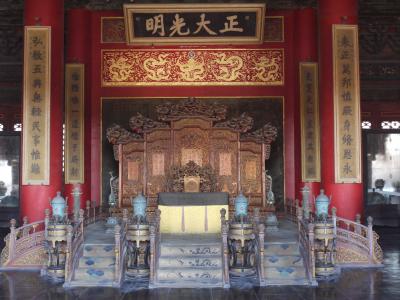
|
| Forbidden City in Beijing | |
In regular intervals there are loudspeaker announcements in Chinese, introduced by a chime that every time made me expect something like "flight 444 is now boarding at the Gate of Supreme Harmony".
I spent seven hours in the Forbidden City, it's just endless. The audio guide makes it interesting, it's quite good except when it gets confused and plays the wrong message and I don't know what it's talking about. The City was fairly empty when it opened at 8:30, but later on the tour groups descend on the place so it's good to be away from the highlights like the large halls and the garden. There are a lot of guards in military uniforms; two of them patrol the outer wall with walkie-talkies set on full volume, noisily squeaking instructions punctuated by short beeps. Sounds like two Apollo capsules slowly orbiting the city. I don't know how they manage to look so prim in these stuffy uniforms, it's another hot and sunny day.
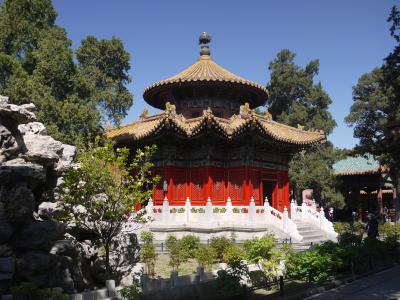
| 
|
| Forbidden City in Beijing | |
Outside the Forbidden City is a pleasant park, admission charged, with many old trees, ponds, and lots of flowers and blooming trees. Lots of Chinese photographers with gigantic cameras took pictures of tulips.
The Forbidden City borders on Tiananmen Square, and the first large guard house has a large Mao portrait over the main entrance, the one only the emperor could use. Official doctrine says that Mao's policies were 70% right and 30% wrong (those 30% include the cultural revolution that destroyed much of China's heritage, and the Great Leap Forward that caused famines across the land), but apart from the Mao pictures everywhere he seems pretty solidly discredited. You can see his pickled body in his mausoleum on the opposite side of Tiananmen Square, but I have seen pickled dictators before (Ho Chi Minh in Hanoi) and if you have seen one you have seen them all.
I had dinner at the Wangfujing snack street. Lots of food stalls there that sell everything on sticks; you point at some and they fry them: chicken, pork, tofu, tentacles, sausages, starfish, seahorses, live scorpions, toads, and thumb-size grubs. I am not kidding. Apart from the tentacles, nobody I saw bought the more exotic options. I loved the sweet ones with what I thought were strawberries, but were some other tangy fruit with large hard seeds.
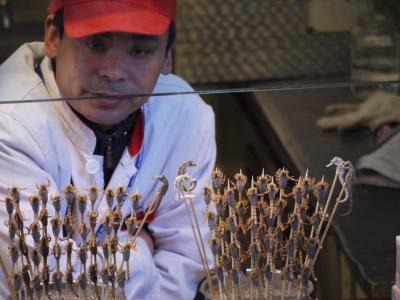
| 
|
| Scorpions, sea horses, and beetles on a stick | Shopping street in Beijing |
Thursday, 16 April 2009
The Emperor didn't want to be holed up in his little Forbidden City all the time, so he also had a summer palace north of Beijing on the shore of a fairly big lake that he had dug. The layout and architecture is pretty similar to the Forbidden City, minus the big reception halls, but a lot smaller. On the other hand it's scenically built up Longevity Hill, which they created with the earth excavated to create the lake. No expenses spared. The three-story theater is basically a copy from the Forbidden City.
Much of it was destroyed by the Western allied powers in 1860 and rebuilt for Empress Cixi's birthday parties. Cixi was faced with an unsolvable problem - repelling Western invaders with far superior weaponry - but she had a knack for not solving them in singularly inept ways, like squandering the treasury on her lifestyle. The money for the summer palace was supposed to be used to create a navy; she had a huge ugly marble boat built instead. When she died, she named a hapless three-year old boy, Pu Yi, as her successor, but the game was up three years later and more than two millennia of Chinese emperors came to an end.
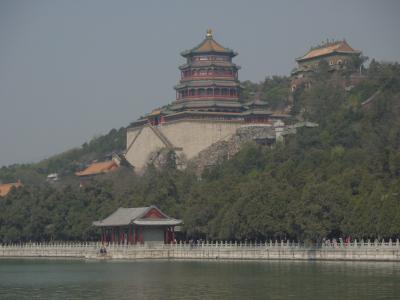
| 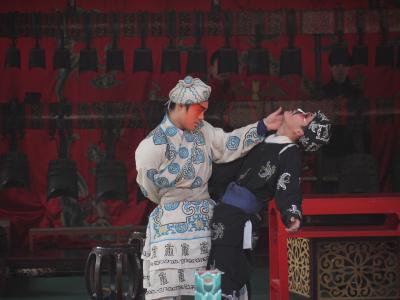
|
| Summer palace near Beijing | Chinese opera at the summer palace |
The palace is in a quite pleasant park. There are lots of tour groups here, even though it's a Thursday and I am still surfing the edge of the low season. Fortunately tour groups never stray far and clog a few major sights while leaving everything else blissfully empty. Near the entrance, a group was dancing to the tune of "Jingle Bells". They also had a theater troupe playing bite-sized Chinese Opera scenes for the tourists in the Empress's three-story theater, a copy of the one in the Forbidden City in Beijing.
Back in Beijing, I went to the old Bell and Drum Towers, the center of Beijing in Mongol times. There are lots of old hutongs (narrow lanes) around them. There is lots of repair and construction work done there - it looks as if China had decided that Chinese culture and historic quarters are maybe valuable after after all and worth preserving, not only the buildings but also the style of the neighborhood. Shadows of Pingyao. (But only shadows.) The quarter could do with fewer pizza joints though. Next time I am in Beijing I think I'll pick a hotel here.
Friday, 17 April 2009
The next day I was mopping up some remaining temples and parks in Beijing. The Temple of Heaven is the most famous temple in the world, says the Chinese guide. If you didn't know that, kindly consider yourself informed now. It's very pretty and harmonious. For the ancient Chinese, the earth is square and heaven is round, so there are many round temples here, with blue glazed tiered roofs, built on white terraces. The emperor held ceremonies here requesting a good harvest, and they sacrificed animals. I stood on the Supreme Ultimate Stone in the middle of it, I suppose all the other stones in the world are either less supreme or less ultimate, or both.
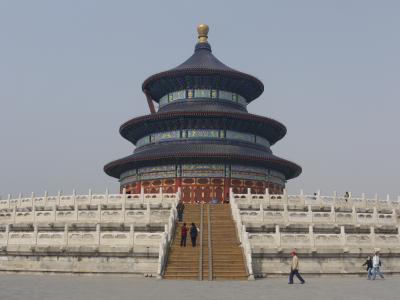
| 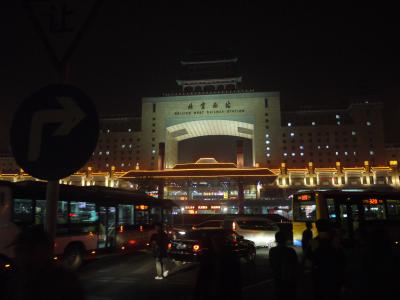
|
| Temple of Heaven in Beijing | Beijing's main train station |
At the end of my week in Beijing, my Tibet expedition was all set. I had my permits and had a train ticket arranged. This night I'll be on my way to Lhasa, riding the train for 46 hours over passes in the Himalayas more than 5000 meters high. Tibet travel is tightly regulated, more so than in recent years: all my stops had to be approved, and I'll have a guide at all times. I'll spend two nights on the train, three nights in Lhasa, and one each in Gyantse, Shigatse, Tingri, and Zhangmu on an overland jeep trip to Kathmandu in Nepal. I had to join a tour group, it can't be done any other way. I am the only member of my group. For money they'll sell anything.
I have deleted my flickr albums because I no longer trust US cloud services.
If you liked this report and would like to read my exotic travel guide, click here.